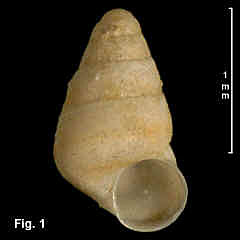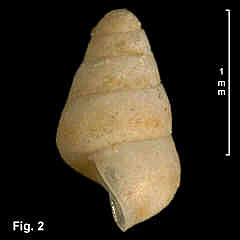|
|
EATONIELLIDAE |
|
|
|
Crassitoniella erratica (May, 1912) Description: Shell minute, solid, conical. Spire outline straight or weakly convex. Protoconch of 1½ whorls. Teleoconch of about 4 slightly rounded whorls. No spiral or axial sculpture. Aperture oval, flared anteriorly; outer lip simple, sharp, straight in profile, with weak to moderate low, rounded varix before outer lip; inner lip separated from base anteriorly. Umbilicus usually closed, sometimes present as a narrow slit. Shell transparent or translucent, becoming opaque with age, colourless or yellowish, often with an orange band on base, level with top of aperture, and rarely another above periphery. Size: Up to 2.5 mm in length but NSW specimens usually 1.5-1.9 mm. Distribution: Endemic to Australia; north Queensland, southwards and around southern Australia, to south-western WA, including Tasmania. Habitat: Lives in the lower littoral and down to at least 150 m; uncommonly found in beach washup. Comparison: This is identifiable by the relatively tall, conical, almost straight-sided shell, the varix before the outer lip and orange spiral bands. But the varix is variable in strength and is often absent, and the orange bands are absent in the majority of shells, resulting in plain shells which are fairly nondescript in character. Remarks: The growing edge of the last whorl is thin and fragile, and usually broken away after the low varix. There is some variation in size and shape of shells, with northern specimens being larger and more slender. Figs. 1, 2: South Solitary Island, NSW (C.213936) |
|

